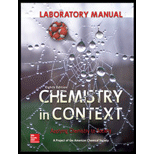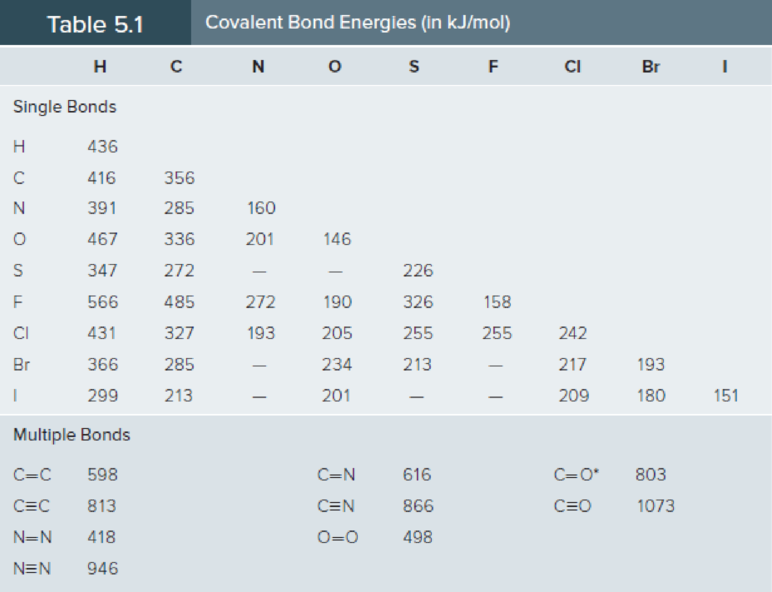
Laboratory Manual Chemistry in Context
8th Edition
ISBN: 9780073518121
Author: American Chemical Society
Publisher: McGraw-Hill Education
expand_more
expand_more
format_list_bulleted
Concept explainers
Textbook Question
Chapter 4, Problem 45Q
Use the bond energies in Table 5.1 to explain why chlorofluorocarbons (CFCs) are so stable. Also explain why it takes less energy to release Cl atoms from CFCs than it does to release F atoms and connect this to HFCs as replacements for CFCs.

*In CO2
Expert Solution & Answer
Want to see the full answer?
Check out a sample textbook solution
Students have asked these similar questions
Draw the formula of the product obtained by reacting adipic acid 1st with PCl5 and 2nd treatment with NH3.
please help me with my homework
help
Chapter 4 Solutions
Laboratory Manual Chemistry in Context
Ch. 4.1 - Although power plants require several steps to...Ch. 4.1 - Prob. 4.3YTCh. 4.2 - Prob. 4.5CTCh. 4.3 - Prob. 4.7CTCh. 4.3 - Prob. 4.9YTCh. 4.4 - Prob. 4.10CTCh. 4.4 - The combustion of one gram of natural gas releases...Ch. 4.4 - Prob. 4.12CTCh. 4.5 - Prob. 4.14SCCh. 4.5 - Scientific Practices Coal Versus Ethanol On the...
Ch. 4.6 - Prob. 4.17YTCh. 4.7 - Beginning in the 1920s, the octane-booster...Ch. 4.9 - Prob. 4.21CTCh. 4.10 - Prob. 4.22CTCh. 4.11 - Have you ever been served cherries Jubilee or...Ch. 4.11 - Prob. 4.26CTCh. 4 - Prob. 4.1CTCh. 4 - Prob. 1QCh. 4 - Prob. 2QCh. 4 - Prob. 3QCh. 4 - Energy exists in different forms in our natural...Ch. 4 - A coal-burning power plant generates electrical...Ch. 4 - Prob. 6QCh. 4 - Prob. 7QCh. 4 - Prob. 8QCh. 4 - Mercury (Hg) is present in trace amounts in coal,...Ch. 4 - Prob. 10QCh. 4 - Here are the condensed structural formulas for two...Ch. 4 - Prob. 12QCh. 4 - Prob. 13QCh. 4 - Prob. 14QCh. 4 - During petroleum distillation, kerosene and...Ch. 4 - Prob. 16QCh. 4 - a. Write the balanced chemical equation for the...Ch. 4 - Prob. 18QCh. 4 - Prob. 19QCh. 4 - State whether these processes are endothermic or...Ch. 4 - Use the bond energies in Table 5.1 to calculate...Ch. 4 - Use the bond energies in Table 5.1 to calculate...Ch. 4 - Ethanol can be produced by fermentation. Another...Ch. 4 - Here are structural formulas for ethane, ethene...Ch. 4 - These three compounds all have the same chemical...Ch. 4 - Catalysts speed up cracking reactions in oil...Ch. 4 - Explain why cracking is a necessary part of the...Ch. 4 - Consider this equation representing the process of...Ch. 4 - Prob. 29QCh. 4 - Consider these three alcohols: methanol, ethanol,...Ch. 4 - Prob. 31QCh. 4 - Prob. 32QCh. 4 - Prob. 33QCh. 4 - Compare and contrast a molecule of biodiesel with...Ch. 4 - Use Figure 5.6 to compare the energy released for...Ch. 4 - Prob. 36QCh. 4 - The sustainability of burning coal (and other...Ch. 4 - In this chapter, we approximated the chemical...Ch. 4 - Prob. 39QCh. 4 - Compare the processes of combustion and...Ch. 4 - How might you explain the difference between...Ch. 4 - Write a response to this statement: Because of the...Ch. 4 - The concept of entropy and probability is used in...Ch. 4 - Bond energies such as those in Table 5.1 are...Ch. 4 - Use the bond energies in Table 5.1 to explain why...Ch. 4 - Prob. 46QCh. 4 - Prob. 47QCh. 4 - Prob. 48QCh. 4 - Prob. 49QCh. 4 - Prob. 50QCh. 4 - Prob. 51QCh. 4 - Prob. 52QCh. 4 - Prob. 53QCh. 4 - Use a diagram to show the relationship among these...Ch. 4 - On a timescale of a few years, the combustion of...Ch. 4 - Prob. 56QCh. 4 - Emissions of some pollutants are lower when...Ch. 4 - Although coal contains only trace amounts of...Ch. 4 - Prob. 59QCh. 4 - An article in Scientific American pointed out that...Ch. 4 - C. P. Snow, a noted scientist and author, wrote an...Ch. 4 - Chemical explosions are very exothermic reactions....Ch. 4 - Prob. 64QCh. 4 - Tetraethyllead (TEL) was first approved for use in...Ch. 4 - Tetraethyllead (TEL) has an octane rating of 270....Ch. 4 - Another type of catalyst used in the combustion of...Ch. 4 - Figure 5.8 shows energy differences for the...Ch. 4 - Prob. 69Q
Additional Science Textbook Solutions
Find more solutions based on key concepts
45. Calculate the mass of nitrogen dissolved at room temperature in an 80.0-L home aquarium. Assume a total pre...
Chemistry: Structure and Properties (2nd Edition)
Label each statement about the polynucleotide ATGGCG as true or false. The polynucleotide has six nucleotides. ...
General, Organic, and Biological Chemistry - 4th edition
The validity of a scientific law.
Physical Universe
Describe the role and impact of microbes on the earth.
Microbiology Fundamentals: A Clinical Approach
Some people compare DNA to a blueprint stored in the office of a construction company. Explain how this analogy...
Biology: Concepts and Investigations
Knowledge Booster
Learn more about
Need a deep-dive on the concept behind this application? Look no further. Learn more about this topic, chemistry and related others by exploring similar questions and additional content below.Similar questions
- The temperature on a sample of pure X held at 1.25 atm and -54. °C is increased until the sample boils. The temperature is then held constant and the pressure is decreased by 0.42 atm. On the phase diagram below draw a path that shows this set of changes. pressure (atm) 2 0 0 200 400 temperature (K) Xarrow_forwardQUESTION: Answer Question 5: 'Calculating standard error of regression' STEP 1 by filling in all the empty green boxes *The values are all provided in the photo attached*arrow_forwardpressure (atm) 3 The pressure on a sample of pure X held at 47. °C and 0.88 atm is increased until the sample condenses. The pressure is then held constant and the temperature is decreased by 82. °C. On the phase diagram below draw a path that shows this set of changes. 0 0 200 temperature (K) 400 аarrow_forward
- er your payment details | bar xb Home | bartleby x + aleksogi/x/isl.exe/1o u-lgNskr7j8P3jH-1Qs_pBanHhviTCeeBZbufuBYT0Hz7m7D3ZcW81NC1d8Kzb4srFik1OUFhKMUXzhGpw7k1 O States of Matter Sketching a described thermodynamic change on a phase diagram 0/5 The pressure on a sample of pure X held at 47. °C and 0.88 atm is increased until the sample condenses. The pressure is then held constant and the temperature is decreased by 82. °C. On the phase diagram below draw a path that shows this set of changes. pressure (atm) 1 3- 0- 0 200 Explanation Check temperature (K) 400 X Q Search L G 2025 McGraw Hill LLC. All Rights Reserved Terms of Use Privacy Cearrow_forward5.arrow_forward6.arrow_forward
- 0/5 alekscgi/x/sl.exe/1o_u-IgNglkr7j8P3jH-IQs_pBaHhvlTCeeBZbufuBYTi0Hz7m7D3ZcSLEFovsXaorzoFtUs | AbtAURtkqzol 1HRAS286, O States of Matter Sketching a described thermodynamic change on a phase diagram The pressure on a sample of pure X held at 47. °C and 0.88 atm is increased until the sample condenses. The pressure is then held constant and the temperature is decreased by 82. °C. On the phase diagram below draw a path that shows this set of changes. 3 pressure (atm) + 0- 0 5+ 200 temperature (K) 400 Explanation Check X 0+ F3 F4 F5 F6 F7 S 2025 McGraw Hill LLC All Rights Reserved. Terms of Use Privacy Center Accessibility Q Search LUCR + F8 F9 F10 F11 F12 * % & ( 5 6 7 8 9 Y'S Dele Insert PrtSc + Backsarrow_forward5.arrow_forward9arrow_forward
- alekscgi/x/lsl.exe/1o_u-IgNslkr7j8P3jH-IQs_pBanHhvlTCeeBZbufu BYTI0Hz7m7D3ZS18w-nDB10538ZsAtmorZoFusYj2Xu9b78gZo- O States of Matter Sketching a described thermodynamic change on a phase diagram 0/5 The pressure on a sample of pure X held at 47. °C and 0.88 atm is increased until the sample condenses. The pressure is then held constant and the temperature is decreased by 82. °C. On the phase diagram below draw a path that shows this set of changes. pressure (atm) 3- 200 temperature (K) Explanation Chick Q Sowncharrow_forward0+ aleksog/x/lsl.exe/1ou-lgNgkr7j8P3H-IQs pBaHhviTCeeBZbufuBYTOHz7m7D3ZStEPTBSB3u9bsp3Da pl19qomOXLhvWbH9wmXW5zm O States of Matter Sketching a described thermodynamic change on a phase diagram 0/5 Gab The temperature on a sample of pure X held at 0.75 atm and -229. °C is increased until the sample sublimes. The temperature is then held constant and the pressure is decreased by 0.50 atm. On the phase diagram below draw a path that shows this set of changes. F3 pressure (atm) 0- 0 200 Explanation temperature (K) Check F4 F5 ☀+ Q Search Chill Will an 9 ENG F6 F7 F8 F9 8 Delete F10 F11 F12 Insert PrtSc 114 d Ararrow_forwardx + LEKS: Using a phase diagram a X n/alekscgi/x/lsl.exe/10_u-IgNsikr7j8P3jH-IQs_pBan HhvlTCeeBZbufu BYTI0Hz7m7D3ZcHYUt80XL-5alyVpw ○ States of Matter Using a phase diagram to find a phase transition temperature or pressure Use the phase diagram of Substance X below to find the melting point of X when the pressure above the solid is 1.1 atm. pressure (atm) 16 08- solid liquid- 0 200 400 gas 600 temperature (K) Note: your answer must be within 25 °C of the exact answer to be graded correct. × 5arrow_forward
arrow_back_ios
SEE MORE QUESTIONS
arrow_forward_ios
Recommended textbooks for you
 General Chemistry - Standalone book (MindTap Cour...ChemistryISBN:9781305580343Author:Steven D. Gammon, Ebbing, Darrell Ebbing, Steven D., Darrell; Gammon, Darrell Ebbing; Steven D. Gammon, Darrell D.; Gammon, Ebbing; Steven D. Gammon; DarrellPublisher:Cengage Learning
General Chemistry - Standalone book (MindTap Cour...ChemistryISBN:9781305580343Author:Steven D. Gammon, Ebbing, Darrell Ebbing, Steven D., Darrell; Gammon, Darrell Ebbing; Steven D. Gammon, Darrell D.; Gammon, Ebbing; Steven D. Gammon; DarrellPublisher:Cengage Learning Living By Chemistry: First Edition TextbookChemistryISBN:9781559539418Author:Angelica StacyPublisher:MAC HIGHER
Living By Chemistry: First Edition TextbookChemistryISBN:9781559539418Author:Angelica StacyPublisher:MAC HIGHER World of Chemistry, 3rd editionChemistryISBN:9781133109655Author:Steven S. Zumdahl, Susan L. Zumdahl, Donald J. DeCostePublisher:Brooks / Cole / Cengage Learning
World of Chemistry, 3rd editionChemistryISBN:9781133109655Author:Steven S. Zumdahl, Susan L. Zumdahl, Donald J. DeCostePublisher:Brooks / Cole / Cengage Learning Chemistry & Chemical ReactivityChemistryISBN:9781337399074Author:John C. Kotz, Paul M. Treichel, John Townsend, David TreichelPublisher:Cengage Learning
Chemistry & Chemical ReactivityChemistryISBN:9781337399074Author:John C. Kotz, Paul M. Treichel, John Townsend, David TreichelPublisher:Cengage Learning Chemistry & Chemical ReactivityChemistryISBN:9781133949640Author:John C. Kotz, Paul M. Treichel, John Townsend, David TreichelPublisher:Cengage Learning
Chemistry & Chemical ReactivityChemistryISBN:9781133949640Author:John C. Kotz, Paul M. Treichel, John Townsend, David TreichelPublisher:Cengage Learning Introductory Chemistry: A FoundationChemistryISBN:9781337399425Author:Steven S. Zumdahl, Donald J. DeCostePublisher:Cengage Learning
Introductory Chemistry: A FoundationChemistryISBN:9781337399425Author:Steven S. Zumdahl, Donald J. DeCostePublisher:Cengage Learning

General Chemistry - Standalone book (MindTap Cour...
Chemistry
ISBN:9781305580343
Author:Steven D. Gammon, Ebbing, Darrell Ebbing, Steven D., Darrell; Gammon, Darrell Ebbing; Steven D. Gammon, Darrell D.; Gammon, Ebbing; Steven D. Gammon; Darrell
Publisher:Cengage Learning

Living By Chemistry: First Edition Textbook
Chemistry
ISBN:9781559539418
Author:Angelica Stacy
Publisher:MAC HIGHER

World of Chemistry, 3rd edition
Chemistry
ISBN:9781133109655
Author:Steven S. Zumdahl, Susan L. Zumdahl, Donald J. DeCoste
Publisher:Brooks / Cole / Cengage Learning

Chemistry & Chemical Reactivity
Chemistry
ISBN:9781337399074
Author:John C. Kotz, Paul M. Treichel, John Townsend, David Treichel
Publisher:Cengage Learning

Chemistry & Chemical Reactivity
Chemistry
ISBN:9781133949640
Author:John C. Kotz, Paul M. Treichel, John Townsend, David Treichel
Publisher:Cengage Learning

Introductory Chemistry: A Foundation
Chemistry
ISBN:9781337399425
Author:Steven S. Zumdahl, Donald J. DeCoste
Publisher:Cengage Learning
Calorimetry Concept, Examples and Thermochemistry | How to Pass Chemistry; Author: Melissa Maribel;https://www.youtube.com/watch?v=nSh29lUGj00;License: Standard YouTube License, CC-BY